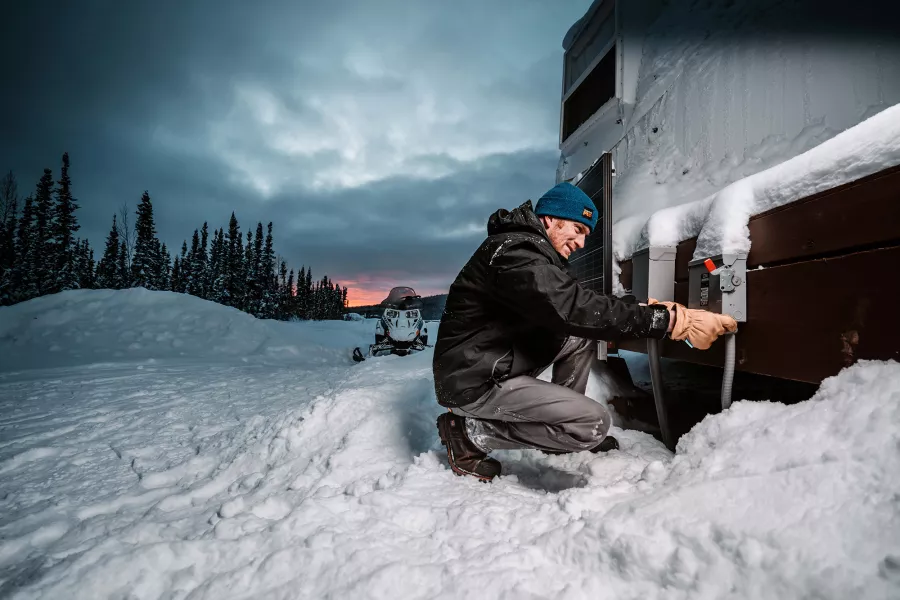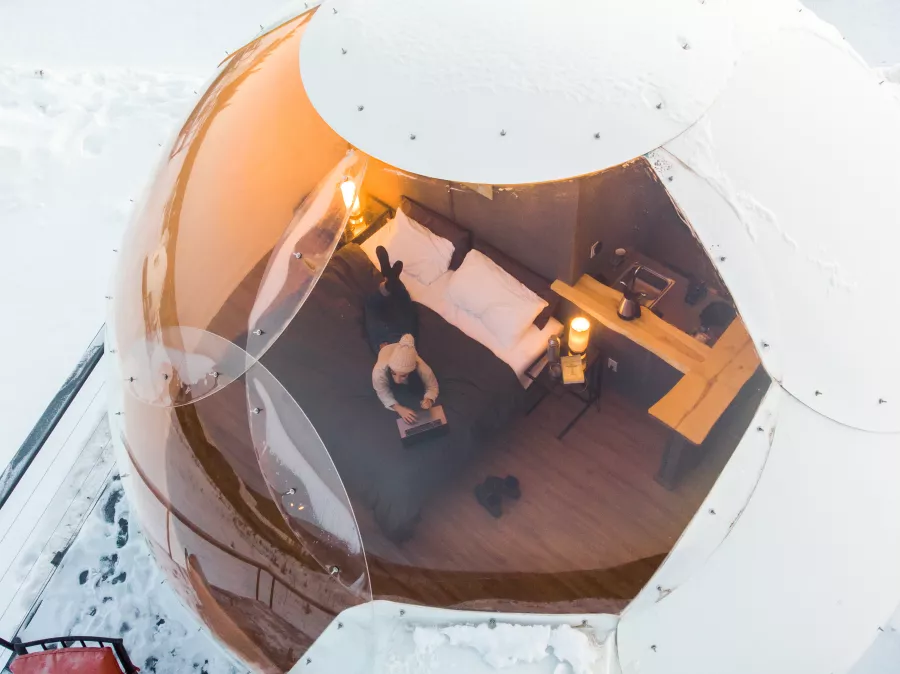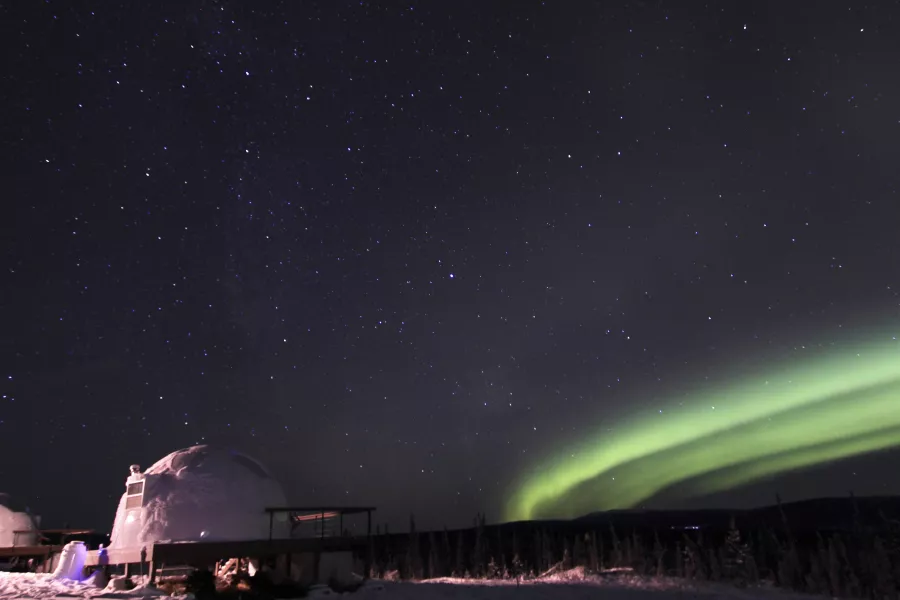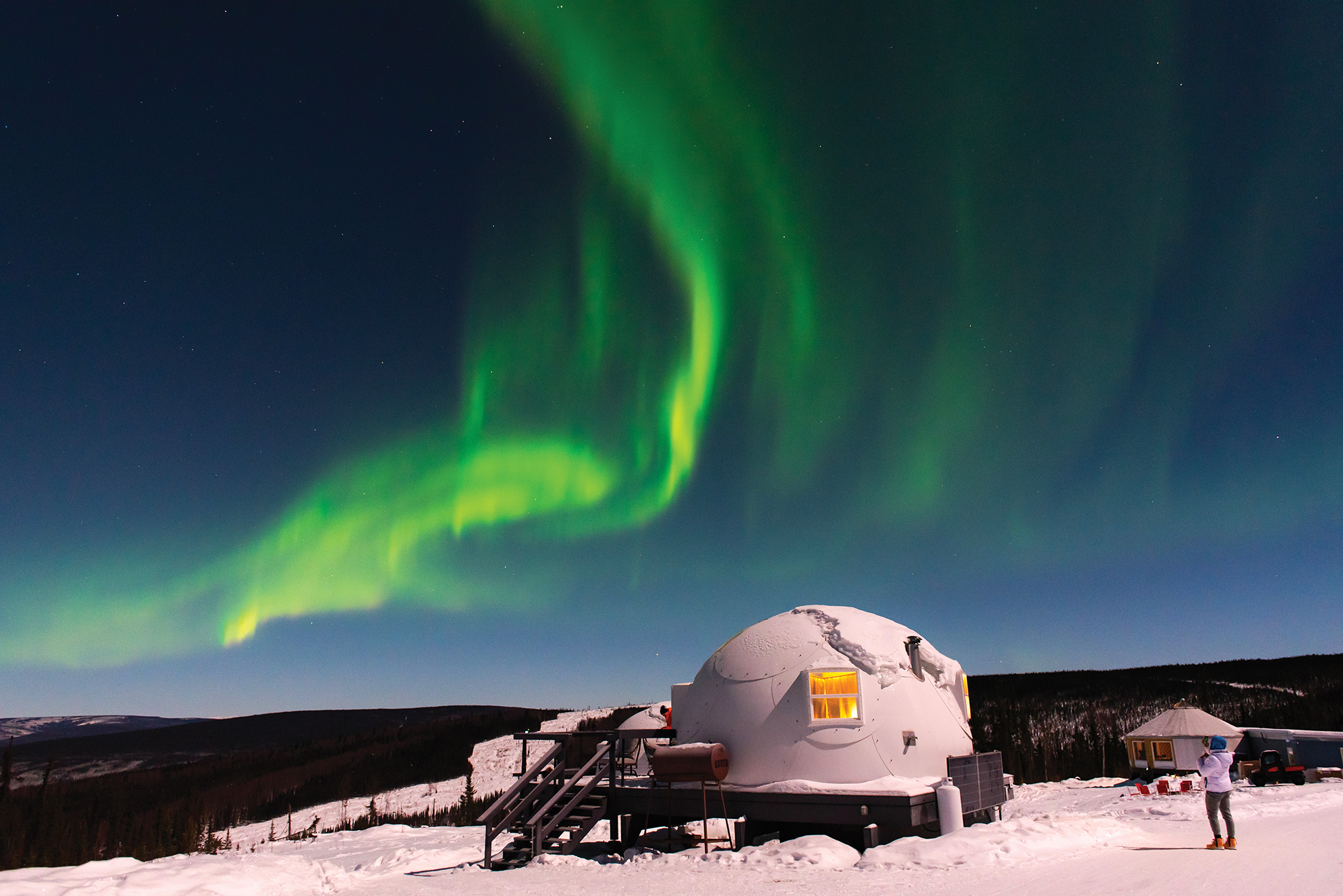Radioactivity
For those who revel in the warmth of summer, August ushers in a necessary accounting of the scant weeks remaining of ample sunlight. These are the days of last-chance outdoor barbecues, urgent trips to the beach to frolic in ocean waves, or time spent purposefully lounging by the pool before the first twinge of a chill is felt.
In August, Adriel Butler, ’08, B.S., manufacturing and supply chain management, makes plans to celebrate the sun in the polar opposite of summer climates. He’s the founder of Borealis Basecamp, a resort near Fairbanks, Alaska, that is the first in North America devoted to providing a private, luxurious view of the northern lights.
“On an evening where it’s radiant and dancing it’s utterly indescribable”
By late August in Fairbanks the chill of fall evenings is already felt in the air and daylight hours are well on their way to retreating to the darkness of night. This is aurora borealis season, when much of Alaska's tourism economy goes into hibernation. Offseason or not, since 20217 tourists to Borealis Basecamp have been taking advantage of Fairbanks's sub-Artic location and ideal placement under the aurora oval -- a ring-shaped zone at both poles where charged particles from the solar wind hit Earth's atmosphere and cause the celestial display.

While sunlight never really disappears altogether around Fairbanks, the blackout that characterizes the aurora season from August to March in truth stains the sky a deep indigo. As if on cue from Mother Nature, the darkness allows for missives from the sun, messages painted in red, purple, and green streaks that flit and flutter against the opaque sky.
“On an evening where it’s radiant and dancing it’s utterly indescribable,” says Butler, who continues to have an active role in operations at the resort.
The aurora occurs when the sun hurls plasma toward the Earth at temperatures of up to 2 million degrees Fahrenheit in a phenomenon known as the solar wind. Contained in the plasma are protons and electrons. These protons and electrons bash into the Earth’s magnetic field and are funneled to the poles where they hit atmosphere. The sashaying of the aurora in the sky are the particles emitting energy. While the color green is most common the aurora can be seen to have purples, reds and pinks. The array of visible colors is due to the types of particles and their altitude in the atmosphere: Oxygen makes red and green light, and atomic nitrogen makes blue light, while molecular nitrogen makes purple. According to Space.com, the green lights typically appear in areas up to 150 miles high, and red above 150 miles; blue usually appears at up to 60 miles; and purple and violet above 60 miles.
The primary distinguishing characteristics of the Borealis Basecamp experience are the patented geodome lodgings with see-through roofs that allow guests to observe the aurora boogying outside while staying snug in their eco lodges. Staying at Borealis Basecamp is a bit like dropping in on a well-decorated off-world space station. In the winter the eco lodges are covered in snow, giving the landscape a Moonbase Alpha aesthetic á la the 1975 BBC science fiction series “Space: 1999.” The guest lodgings are outfitted in neutral gray and white, and feature mid-century-inspired furnishings, as well as a full-sized bathroom. The bathroom boasts a dry toilet, a mechanical delight whose flush, reminiscent of watching Jiffy-Pop popcorn heat up, has propelled the commode to social media stardom on more than one influencer’s YouTube channel.

The notions for the guest lodging structures were seeded during Butler’s tinkering with automotive design in Western’s Vehicle Research Institute with Formula SAE racing cars. Building the carbon fiber bodies of the prototype race cars was a precursor to developing the geodesic domes—structures comprised of straight lines on a curved space that form octagons—that shelter Borealis Basecamp guests today.
“VRI taught me something important in manufacturing: that something can work on paper and in theoretical calculations, but not work well in real life, and vice versa. Something might not look like it’s going to work at all on paper, but a material, or a design, could perform well in the real world. I would never have founded Borealis Basecamp without that feeling of just having to push forward, regardless of the data,” he says.
Another experience behind the birth of Borealis Basecamp was Butler’s internship at a lean manufacturing company in Xiamen, China, where Butler got a front-row seat to the artistry of manufacturing and supply chains working in tandem with one another. It helped him to “really kind of understand the interplay between international economies, manufacturing costs and how they played together to create an entire product portfolio,” he said. He also learned about single-piece manufacturing, a process where products are made just in time, without all the traditional inventory and batch processing.
Later, Butler lived and worked in China for five years and, most importantly, built relationships that would be critical for the basecamp’s future. In his pitch in 2017 to Accelerate Alaska, a regional economic growth initiative, Butler spoke of catering to an emerging Chinese clientele that was willing to travel fairly independently and without a lot of notice.
Other markets like Iceland and Sweden were capturing the bulk of visitors who sought to experience the dancing and mystical lights. But there was nothing like it in Fairbanks—or the entirety of North America, for that matter. And so Borealis Basecamp was founded.
In 2018 Butler continued to strengthen those international connections when he participated in signing with a Chinese tourism marketing association as part of a tourism initiative with Explore Fairbanks, the city’s destination marketing organization.
The 2018 agreement was also indicative of a steady increase of international visitors to the region. In 2016 a tourism assessment found about 16 percent of visitors to Fairbanks were international, significantly higher than the statewide rate of 9 percent.
While Borealis Basecamp is just 20 miles outside of Fairbanks, aurora time is slower and the vibe of aurora season is more zen than day-trip tourist. “Basecamp is not true fly-in-only, in the middle of nowhere, but it introduces you to quietness and stillness dependent on nature,” Butler says. “The aurora is not something you can go take a picture of and say you’re done.”

Endeavoring to view the celestial phenomenon can still seem anachronistic in an age of constant digital inundation and immediate gratification, but that’s part of the experience, according to Butler.
“You have to be persistent and patient and not get upset when you don’t see it the first night. A lot of what we do is around setting expectations and introducing people to a slower pace of life that is typical of an off-grid community,” Butler says.
Many aurora hunters in fact caution travelers that seeing the aurora isn’t guaranteed in any location, and should not be the primary reason to travel to an aurora zone. At Borealis Basecamp guests may also emerge from their domes during the day to mush sled dogs, take a photography class, cavort with reindeer, snow machine in the forest, or lounge in the community yurt to dine on artisan-crafted meals in anticipation of the supernatural event.
While the aurora can be seen 250 nights out of the year according to the Borealis Basecamp website, visitors who stay the Fairbanks area at least three nights increase their chances of seeing the phenomenon to 90 percent. Guests have an aurora bat-phone of sorts that dings when the aurora is out; guests can also get alerts on their cell phones.
In spite of the pandemic’s challenges to the tourism industry, 2020 was the best season Borealis Basecamp has had to date. Miraculously only one guest had to be put in isolation at another location throughout the entirety of last year’s aurora season.
“We were blown away by guests’ willingness to travel even in the middle of a pandemic and have a great attitude about being in the middle of nowhere. We had a fabulous year. I am super, super thankful for that,” says Butler. The future looks bright for sun worshippers of all kinds who are hankering to travel this summer and into next year. In May Congress passed the Alaska Tourism Restoration Act which allows large cruise ships to operate between the states of Washington and Alaska.
The legislation is good news for Butler as well, as one sector of Alaska’s tourism industry feeds others.
“We’re six months ahead of last year’s performance. If we don’t build more we’ll be sold out before the season begins,” he said. Butler has said that being in the presence of the aurora is mystifying. In the midst of completing mundane tasks such as thawing out pipes in sub-zero temperatures he has looked up to see the aurora out in all her splendor, dancing.
As the tourism industry rebounds in post-COVID Alaska and worldwide, taking a trip to view the aurora seems less frivolous and more thought-provoking: an appropriate way of commemorating the end of metaphorical darkness and communing with the natural world. Indeed, to celebrate both the light and the dark that life has to offer.
Title photo and geodome: The Nomadic People, Butler: Timberland PRO, Aurora: Borealis Basecamp
